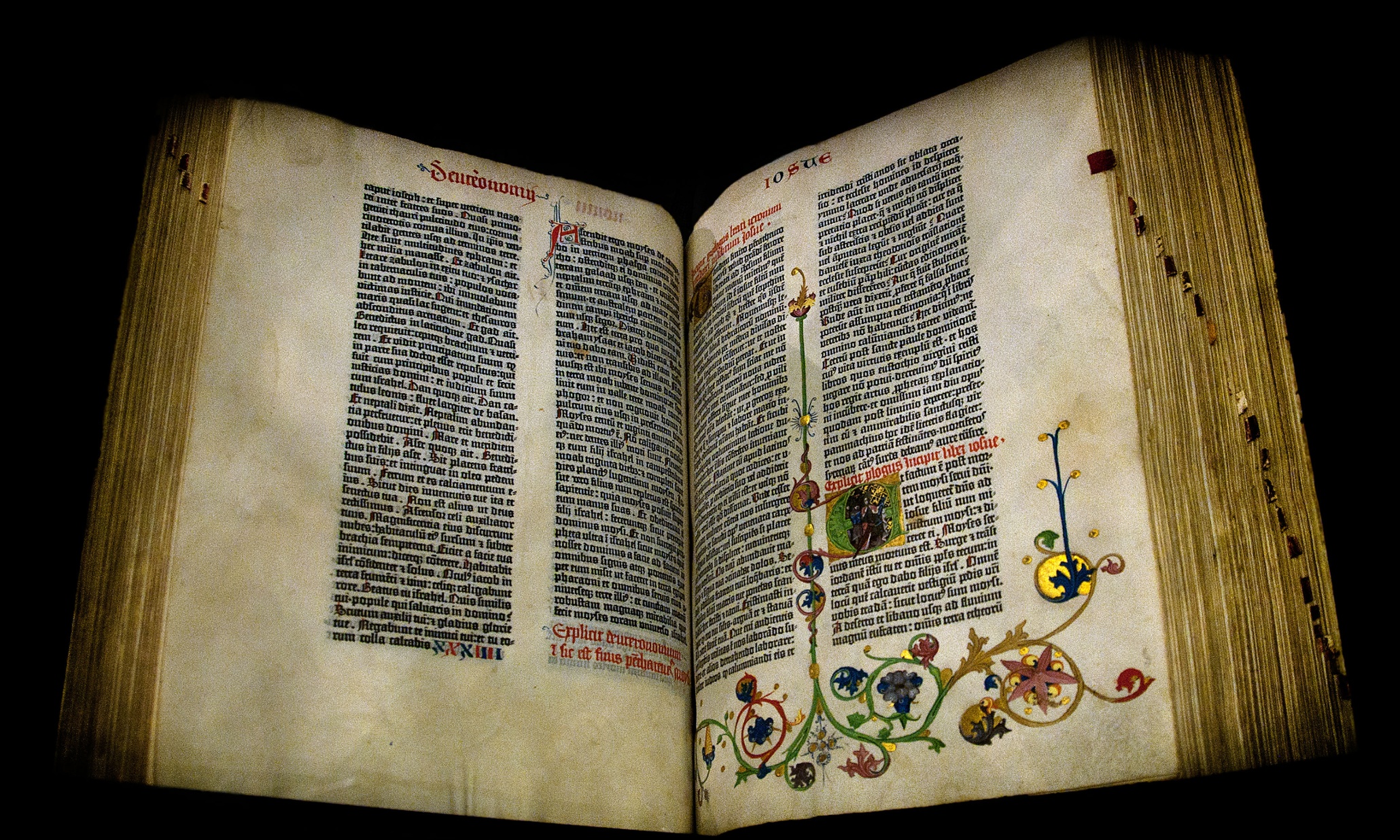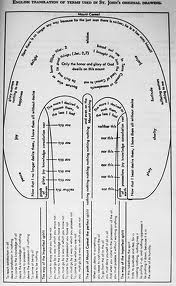
Gutenberg Bible
(Concluded from Part 1, yesterday.)
The Bible is a Treasury of Enlightenment Motifs
With the help of the many commentaries and interpretations now available to us, we can interpret parts of the scriptural code and reveal the Bible for what it is — a rich treasury of enlightenment formulas and motifs, tableaux and dramas. Its word-pictures have already burnt themselves into our collective memories, each there recording something vital about enlightenment.
I’m going to take one example and develop it at some length. It suggests that the Biblical masters had knowledge of the chakra system and the kundalini. We start with a passage from Exodus:
“Be ready in the morning, and come up in the morning unto Mount Sinai, and present thyself there to me in the top of the mount.
“And no man shall come up with thee, neither let any man be seen throughout all the mount; neither let the flocks and herds feed before that mount.” (23)
St. John of the Cross explains the significance of the divine drama of Moses’ ascent up Mount Sinai. St. John shows us that the ascent is a consciously-directed set of actions, designed to leave in our recollection an enlightenment tableau.
“When God ordered Moses to climb to the top of the mountain … He commanded Moses not only to ascend alone, and leave the children of Israel below, but to rule against the pasturing of beasts on the mountainside. [Ex. 34:3] The meaning is that a person ascending this mount of perfection to converse with God must not only renounce all things, by leaving them at the bottom, but also restrict his appetites (the beasts) from pasturing on the mountainside, on things which are not purely God. For in God, or in the state of perfection, all appetites cease.” (24)
St. John of the Cross furnishes us with one clue to the drama here. In another section of his book, he gives us a second clue to unlock the full meaning of the Sinai drama. St. John of the Cross was spiritual director to the nuns and monks of the reformed Carmelite order. He drew a picture once of the ascent up Mount Carmel which he counselled them to undertake. What was the Mount Carmel he depicted? It was the human head. (25)

This is St. John of the Cross’s drawing of “The Ascent of Mt. Carmel”
St. John depicts the human spine ending in the brain. He’s testifying to the knowledge of what Easterners term the kundalini, which Da Free John called “the current of immortal joy.” (26) There are hints in his works that he knew of the chakra system. For instance, he describes his enlightenment experience, making reference to “lilies,” which could be his term for the chakras.
“I abandoned and forgot myself,
Laying my face on my Beloved;
All things ceased; I went out from myself,
Leaving my cares
Forgotten among the lilies.” (27)
The ascent of the kundalini figured prominently in the enlightenment of Franklin Merrell-Woolf. Let us hear a modern-day description of that spiritual energy.
“The Current is clearly a subtle, fluid-like substance which brings the sense of well-being already described. Along with It, a more than earthly Joy suffuses the whole nature. To myself, I called It a Nectar. Now, I recognize It under several names. It is … the ‘Soma,’ the ‘Ambrosia of the Gods,’ the ‘Elixir of Life,’ the ‘Water of Life’ of Jesus, and the ‘Baptism of the Spirit’ of St. Paul. It is more than related to Immortality; in fact it is Identical with Immortality.” (28)
“To the sensuous consciousness it appears [like] a fluid, for there is a sense of ‘flowing through.’ It penetrates all tensions with the effect of physical release. Spots that are not so well feel both rested and stronger. All over and through and through there is a quality that may well be described as physiological happiness. The organism feels no craving for sensuous distraction in order to find enjoyment. The external life of the individual could appear highly ascetic and austere to others, but all the while it would be profoundly happy. …
“I wish, by every means possible, to make the point clear that in the Current lies the highest possible value which, from the relative standpoint, we call enjoyment.” (29)
Sri Ramakrishna tells us that “a man’s spiritual consciousness is not awakened unless his Kundalini is aroused.” (30) The climb of the kundalini from the base of the spine to the crown of the skull is the real ascent of Mount Sinai or Mount Carmel that results in enlightenment. Sri Ramakrishna describes the entire course of the Kundalini up the spine.
The Kundalini dwells in the Muladhara [chakra, at the base of the spine]. When it is aroused, it passes along the Sushumna nerve, goes through the centres of Svadhisthana, Manipura, and so on, and at last reaches the head. (31)
With ordinary people the mind dwells in these [first] three planes, at the organs of evacuation and generation and at the navel. (32)
The awakening of the Kundalini is the beginning of spiritual consciousness, and its union with Siva in the Sahasrara [seventh chakra], ending in samadhi [absorption in God], is the consummation. (33)
St. John’s drawing of the ascent of Mount Carmel implies knowledge of the importance of the body’s spiritual energy system. St. Paul was probably also aware of it. If we know that what Christians call the Holy Spirit Hindus call, among other names, Shakti (Energy) and Mother Kundalini, then we can see the special significance in St. Paul’s observations that the Holy Spirit dwells in the temple of God, which is the human body, as the spiritual energy or kundalini.
“Know ye not that ye are the temple of God, and that the Spirit of God dwelleth in you? (34)
“What? Know ye not that your body is the temple of the Holy Ghost which is in you, which ye have of God, and ye are not your own?” (35)
The body is wholly an artifact of the Holy Spirit, who made matter itself and who resides in the body as the kundalini energy.
King Solomon also betrays knowledge of the kundalini system when he states that “wisdom hath builded her house [the body], she hath hewn out her seven pillars [the chakras].” (36)
The image of Moses climbing Mount Sinai, leaving the Israelites and the beasts of the field at the base of the mountain (probably the fourth chakra, where one experiences the first enlightenment or “spiritual awakening”) and ascending the hill to the top (the seventh chakra) where he receives the law (that is, where one experiences God-Realization or Brahmajnana) is a tableau that prepares us to know the work of the kundalini.
After the spiritual energy reaches the fourth chakra, all our thoughts and appetites (represented by the Israelites and beasts) fall away from us and we journey alone from there (i.e., without the worldly desires of the mind). When the kundalini reaches the seventh or crown chakra, we are united with God and blessed with profound wisdom (i.e., we receive the law).
This encoded enlightenment motif has been impressed on the minds of those who have read the dramatic tale of Moses’ ascent of Mount Sinai; later enlightenment teachings can be mapped onto it. What we might have questioned or rejected if described in straightforward language has been accepted without difficulty when acted out or ensconced in the Biblical code.
Nor is this use of a code restricted to the Bible. Here it is discussed in the Koran. The angelic author testifies to depriving the worldly of the ability to understand the secret lore contained in the scriptures. His words hauntingly echo those of Jesus. Says he:
“We have cast veils over their hearts, lest they should understand Our words, and [have] made them hard of hearing. Call them as you may to the right path, they shall never be guided. (37)
“Allah leaves in error whom He will, and guides those who repent and have faith; whose hearts find comfort in the remembrance of Allah.” (38)
He couches his descriptions of enlightenment in metaphors, knowing that scoffers will not be able to penetrate them: “We coin these similes for the instruction of men; but none will grasp their meaning except the wise.” (39) Thus the scriptural practice of speaking in code was not limited to the Jewish and Christian traditions.
Footnotes
(23) Exodus 34:2-3.)
(24) Kieran Kavanaugh and Otilio Rodriguez, trans. Complete Works of St. John of the Cross. Washington: Institute of Carmelite Studies, 1973, 83. (Hereafter CWSJC.)
(25) Ibid., 66-7.
(26) Da Free John,The Knee of Listening. Original Edition. Clearlake, CA; Dawn Horse Press, 1984; c1973, 157.
(27) CWSJC, 69.
(28) Franklin Merrell-Wolff, Pathways Through to Space. A Personal Record of Transformation in Consciousness. New York: Julian Press, 1973, 31.
(29) Ibid., 20-1.
(30) Swami Nikhilananda, trans., The Gospel of Sri Ramakrishna. New York: Ramakrishna-Vivekananda Center, 1978; c1942, 830. (Hereafter GSR.)
(31) Loc. Cit.
(32) Ibid., 245.
(33) GSR, 22.
(34) I Corinthians 3:16.
(35) I Corinthians 6:19.
(36) Proverbs 9:1.
(37) N.J. Dawood, trans. The Koran. Harmondsworth: Penguin, 1964; c1959, 94.
(38) Ibid., 142.
(39) Ibid., 194

